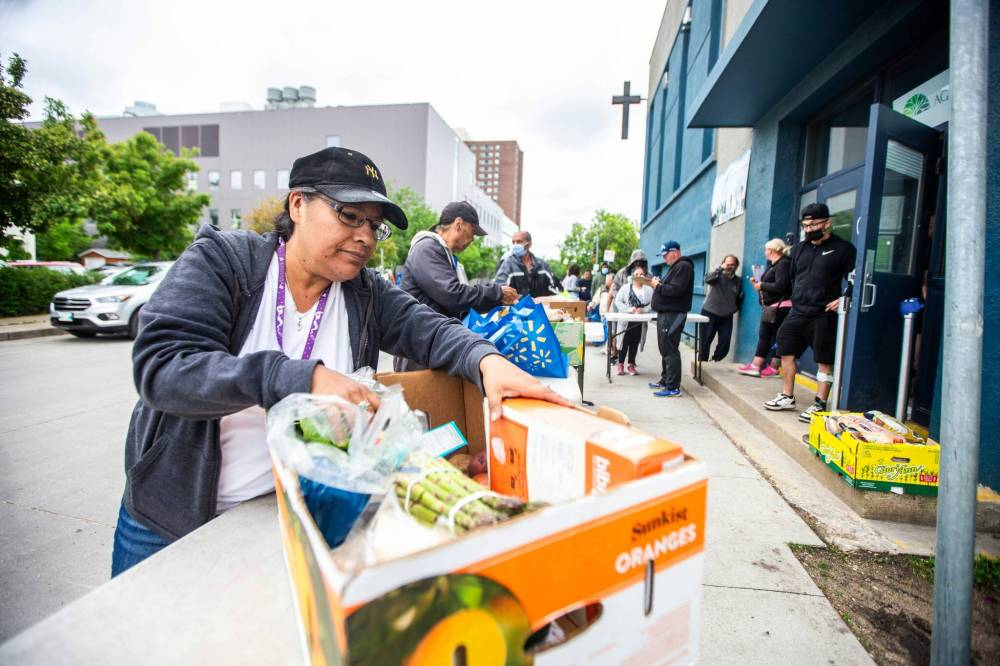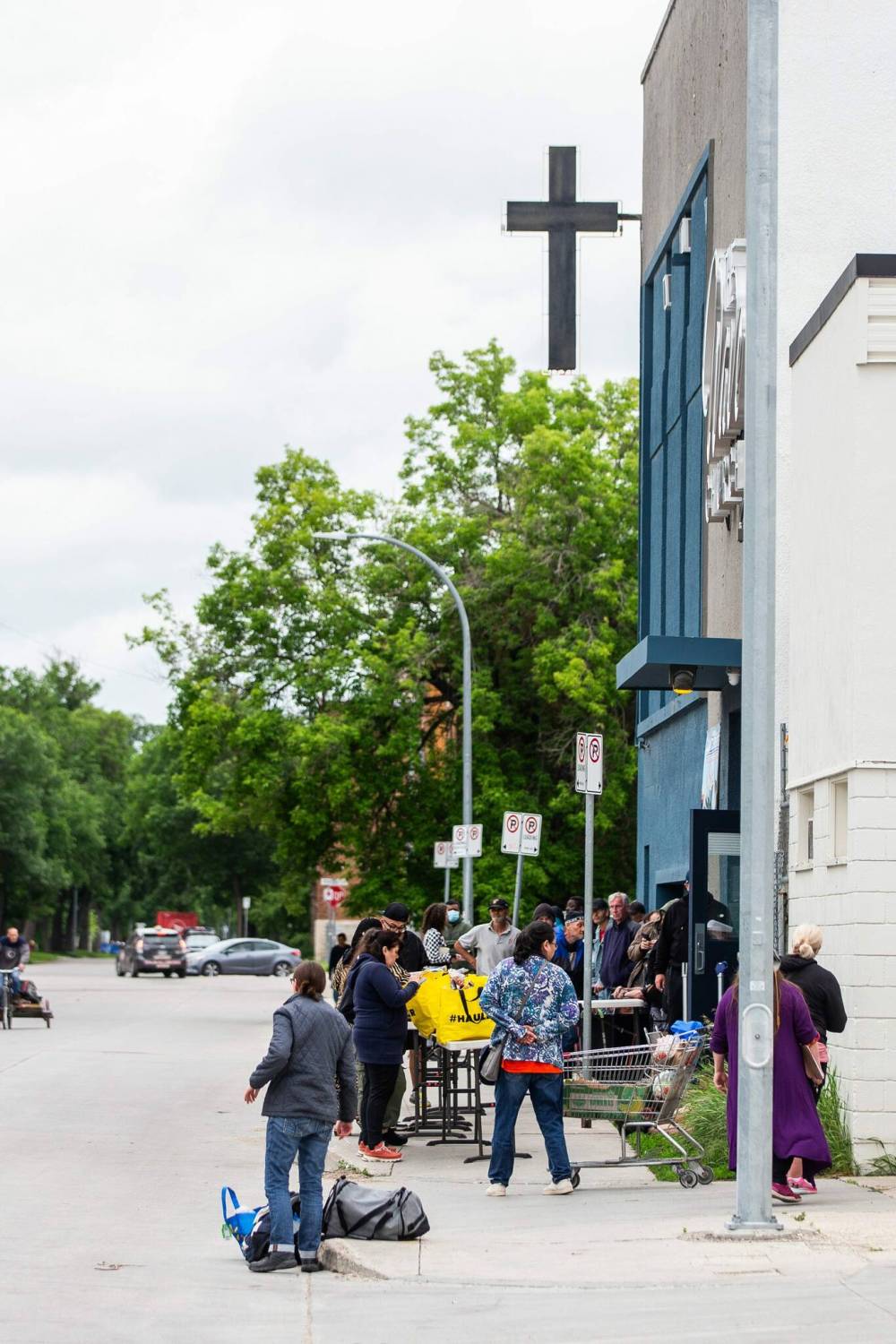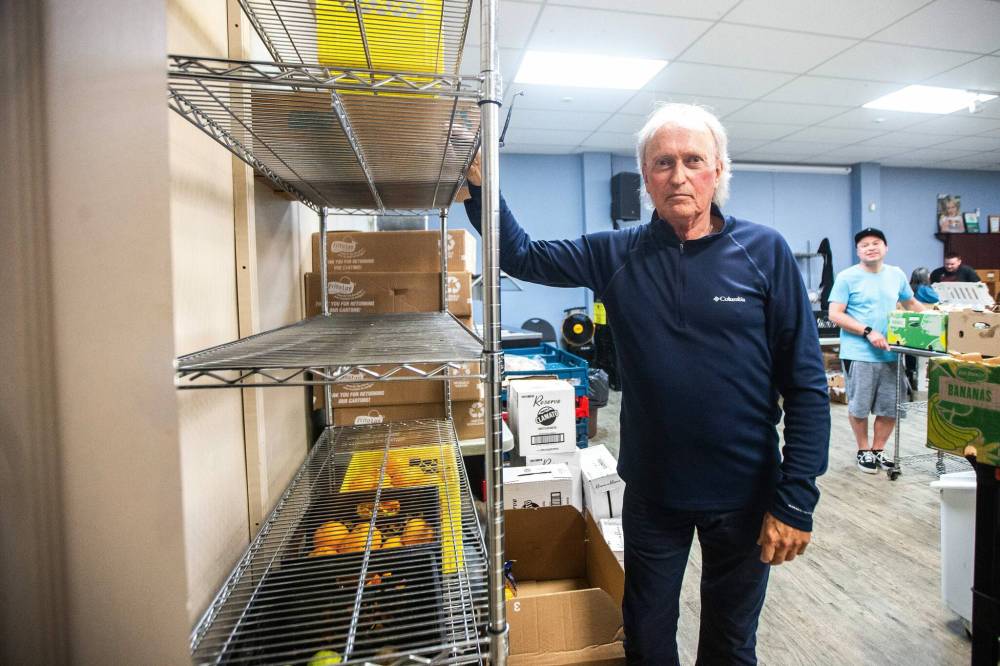Joanne Nimik sees the new faces of poverty every time she gets in line for food hampers from Agape Table.
Nimik, who has been coming to the soup kitchen once a month for years, has recently noticed a wider range of people, including low-income workers, coming in to eat there to leave more food on the table at home for their families.
“It’s sad that they’re trying to do what they can to provide for their family … the money that is allocated to them just doesn’t meet their needs,” Nimik said on Tuesday, standing outside the Wave Church where Agape Table is run.

MIKAELA MACKENZIE / FREE PRESS
Joanne Nimik packs up her food bank box at Agape Table on Furby Street Tuesday.
“When you think about the bills, when you think about rental costs, when you have a family, there’s a little bit more expenses that are involved. With the cost of inflation, it comes down to knowing where to access the resources.”
It’s not just Nimik who sees more people in poverty. A new report by Food Banks Canada has found millions more Canadians are living in poverty than is indicated by the country’s official poverty rate of 10 per cent.
The report, which measures poverty using an index based on what household essentials people would like to have, but can’t afford, found an estimated 25 per cent of Canadians — nearly six million — are living in poverty because they can’t buy at least two or more of 11 items.
Of those items, 18 per cent of Canadians said they can’t afford regular dental care, almost 22 per cent said they wouldn’t be able to cover an unexpected $500 expense, 10 per cent said they don’t own proper clothing to go for a job interview or funeral, and eight per cent said they can’t afford to buy a small gift for family and friends at least once a year.

MIKAELA MACKENZIE / FREE PRESS
A new report by Food Banks Canada found an estimated 25 per cent of Canadians — nearly six million — are living in poverty because they can’t buy at least two or more of 11 items.
While the survey results from Manitoba and Saskatchewan appear to show about one in five, or about 20 per cent of the population, live in poverty, Richard Matern, the report’s co-author and Food Banks Canada’s research director, said the national and provincial numbers are actually about the same.
“It is because of sampling error,” Matern said. “We interviewed 4,600 Canadians and it is actually why we want Statistics Canada to incorporate this index into a future survey.
“There are no substantial differences between any of the provinces … and there is no question Manitoba has very high rates of food insecurity.”
The report also found 44.5 per cent of single-parent families, 42 per cent of renters, and 30 per cent of Canadians aged 18 to 30, can’t afford two or more household essentials each month.
Meaghan Erbus, Harvest Manitoba’s senior manager for advocacy and impact, said the federal government’s market basket method, using the price of a variety of goods and services and then comparing it with the amount of income needed to purchase them, misses many people.
“It doesn’t tell the full story of people living in poverty,” Erbus said. “This report puts it into perspective.
“Lots of people who access food banks are in deep poverty, but 40 per cent of people who come to us are working — even a full time job isn’t enough with many.
“It is often the people with the least who are hit with the most.”
Erbus said the province’s largest food bank helps about 50,000 Manitobans every month.
Siloam Mission CEO Tessa Blaikie Whitecloud wasn’t surprised with the report’s findings.
“We see it every day,” she said. “We see 600 to 800 come to us every day and recently we asked who was housed. Over 25 per cent said they were housed, but they experience not being able to buy groceries. It’s part of the staggering rise in food bank use.”
Meanwhile, Agape Table itself needs help.
Jim Steep, the organization’s executive director, said the record level of need in the community has emptied their shelves. It served 85,000 clients in 2019 and 155,000 in 2023. Last week, Agape Table served 4,162 people.

MIKAELA MACKENZIE / FREE PRESS
Agape Table executive director Jim Steep
“That pushes us to the limit,” said Steep. “I’ve just never seen it like (this). We’re just super low on everything.”
Steep said it forced the not-for-profit to put out a news release asking for donations, including sandwich fillings, fruit, water, jam and granola bars.
“It’s a bit of a crisis situation,” he said. “A lot of people are phoning and just saying, ‘Well, I’ve never had to do this before, but can you help me out with some food?’ It’s tough out there for everybody.”
Donations can be made Monday to Friday at the Wave Church at 364 Furby Street.
Although Nimik doesn’t have a family to support, she said paying for groceries takes an “exorbitant” amount of money out of her small budget and forces her to go to a food bank to supplement her food. She said “sky high” inflation rates hurts even more.
“(COVID) kind of (exacerbated) stuff for folks,” Nimik said. “Now that we’re kind of coming out of that … and things are relatively going back to a semi-state of normal, there’s still going to be that need for a lot of folks.”
kevin.rollason@freepress.mb.ca
jura.mcilraith@freepress.mb.ca

Kevin Rollason
Reporter
Kevin Rollason is a general assignment reporter at the Free Press. He graduated from Western University with a Masters of Journalism in 1985 and worked at the Winnipeg Sun until 1988, when he joined the Free Press. He has served as the Free Press’s city hall and law courts reporter and has won several awards, including a National Newspaper Award. Read more about Kevin.
Every piece of reporting Kevin produces is reviewed by an editing team before it is posted online or published in print — part of the Free Press‘s tradition, since 1872, of producing reliable independent journalism. Read more about Free Press’s history and mandate, and learn how our newsroom operates.
Our newsroom depends on a growing audience of readers to power our journalism. If you are not a paid reader, please consider becoming a subscriber.
Our newsroom depends on its audience of readers to power our journalism. Thank you for your support.